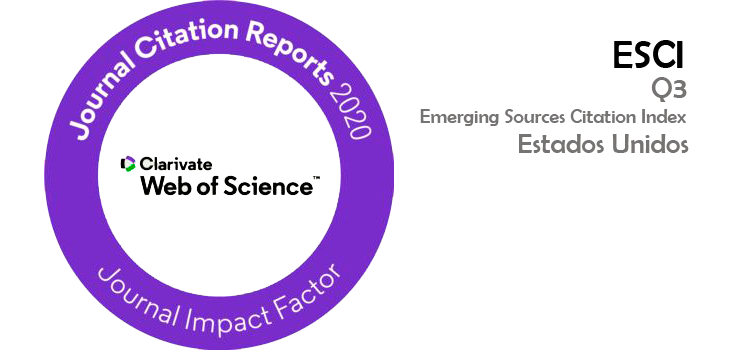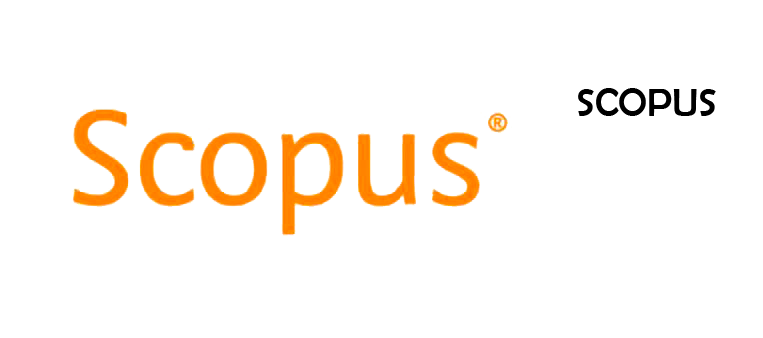
This work is licensed under a Creative Commons Attribution-NonCommercial 4.0 International License.
Authors who publish with this journal agree to the following terms:
- Authors retain copyright and grant the journal right of first publication with the work simultaneously licensed under a Creative Commons Attribution Non-Commercial License that allows others to share the work with an acknowledgement of the work's authorship and initial publication in this journal.
- Authors are able to enter into separate, additional contractual arrangements for the non-exclusive distribution of the journal's published version of the work (e.g., post it to an institutional repository or publish it in a book), with an acknowledgement of its initial publication in this journal.
- Authors are permitted and encouraged to post their work online (e.g., in institutional repositories or on their website) prior to and during the submission process, as it can lead to productive exchanges, as well as earlier and greater citation of published work (See The Effect of Open Access).
Abstract
In the realm of corporate crisis management, the interdependence between safeguarding public opinion and legal fortification stands as a fundamental yet often neglected nexus. This paper addresses this phenomenon, accentuating the exigency for legal professionals to embrace a multifaceted skill set beyond traditional legal domains. The Fabricato case, a once highly reputed Colombian textile company, unfolds as a compelling exemplar, delineating the intricate interplay between legal acumen and crisis management crucial for corporate reputation preservation. Fabricato’s precipitous descent from the apogee of the Ibero-American apparel sector reputation to sudden exclusion stresses the urgency of this discourse. Triggered by an InterBolsaengineered stock market scandal, this reputational crisis uncovered the vulnerabilities of a publicly traded entity, underscoring the indispensable role of crisis lawyering professionals in navigating the aftermath. The media’s amplification, coupled with Fabricato’s delayed and inadequate response, significantly contributed to the escalation of reputational damage, emphasizing the need for legal professionals to comprehend crisis communication complexities. Contrary to crisis management experts’ counsel, Fabricato’s unwise actions allowed the media to craft an unfavorable narrative. This paper contends that the legal community, traditionally advisors, must metamorphose during crises, assimilating crisis management principles and recognizing the nuanced implications of reputation in corporate sustenance. Employing Situational Crisis Communication Theory transcends conventional legal discourse, offering a comprehensive framework for apprehending and addressing reputational crises. It advocates for the expansion of ‘Crisis Lawyering,’ emphasizing its adaptability at the firm level, necessitating a robust infusion of crisis management principles. Scrutinizing crisis phases through media narratives, the paper stresses the evolving role of legal professionals, urging an integrated approach empowering them as strategic defenders not only in courts but also in the influential court of public opinion. This paper thus contributes to a nuanced understanding of the dynamic interplay between law, crisis management, and media in safeguarding corporate reputation.

References
Arias Jiménez, Ferney. “Fabricato busca socio para desarrollo inmobiliario en Ibagué.” El Colombiano, February 8, 2017. https://www.elcolombiano.com/negocios/ fabricato-desarrollo-inmobiliario-en-ibague-KD5894936.
Arias Jiménez, Ferney. “Fabricato se mueve en Ibagué.” El Colombiano, August 22, 2018. https://www.elcolombiano.com/negocios/empresas/ fabricato-negocios-inmobiliarios-BY9203715.
Arias Jiménez,Ferney. “Resultados negativos para Fabricato en el arranque de 2016.” El Colombiano, May 11, 2016. https://www.elcolombiano.com/negocios/ fabricato-resultados-primer-trimestre-2016-CE4125631.
Becerra Ortiz, Jairo, Bibiana Beatriz Luz Clara, John Grover Dorado, John Velandia, Jose Araoz Fleming, and Marco Emilio Sánchez Acevedo. “Implicaciones jurídicas en el entorno del big data: el caso del APP Navega Seguro.” Novum Jus 17, no. 1 (2023): 357-88. https://doi.org/10.14718/NovumJus.2023.17.1.15.
Boel, Werner. “In Crisis, What Makes Lawyers Leaders? - Business Law Today from ABA.” Accessed January 23, 2024. https://businesslawtoday.org/2020/11/ crisis-makes-lawyers-leaders/
Brescia, Ray. “Crisis Lawyering: Transnational Ethics for Global Emergencies.” In Oxford Research Encyclopedia of Politics, 2021. https://doi.org/10.1093/ acrefore/9780190228637.013.1965.
Bundy, Jonathan, Michael D. Pfarrer, Cole E. Short, and W. Timothy Coombs. “Crises and Crisis Management: Integration, Interpretation, and Research Development.” Journal of Management 43, no. 6 (2017): 1661-92. https://doi.org/10.1177/0149206316680030.
Carroll, Conor. “Defying a Reputational Crisis - Cadbury’s Salmonella Scare: Why Are Customers Willing to Forgive and Forget?” Corporate Reputation Review 12, no. 1 (2009): 64-82. https://doi.org/10.1057/crr.2008.34.
Claeys, An-Sofie, and Verolien Cauberghe. “The Role of a Favorable Pre-Crisis Reputation in Protecting Organizations during Crises.” Public Relations Review 41, no. 1 (2015): 64-71. https://doi.org/10.1016/j.pubrev.2014.10.013.
Claeys, An-Sofie, Verolien Cauberghe, and Mario Pandelaere. “Is Old News No News? The Impact of Self-Disclosure by Organizations in Crisis.” Journal of Business Research 69, no. 10 (2016): 3963-70. https://doi.org/10.1016/j.jbusres.2016.06.012.
Claeys, An-Sofie, Verolien Cauberghe, and Patrick Vyncke. “Restoring Reputations in Times of Crisis: An Experimental Study of the Situational Crisis Communication Theory and the Moderating Effects of Locus of Control.” Public Relations Review 36, no. 3 (2010): 256-62. https://doi.org/10.1016/j.pubrev.2010.05.004.
Contreras-Pacheco, O.E., and Cyrlene Claasen. “Mired in Deception: Escalating an Environmental Disaster in Colombia.” Journal of Business Strategy 39, no. 2 (2018): 39-46. https://doi.org/10.1108/JBS-04-2017-0058.
Contreras-Pacheco, O.E., Cyrlene Claasen, and Fernando Garrigos-Simon. “Stakeholder Perceptions in Organizational Crisis Management: Exploring Alternative Configurations.” Journal of Management & Organization, (2022), 1-22. https://doi.org/10.1017/ jmo.2022.55.
Coombs, W. Timothy. Ongoing Crisis Communication: Planning, Managing, and Responding. SAGE Publications, Incorporated, 2018.
Coombs, W Timothy. “Protecting Organization Reputations During a Crisis: The Development and Application of Situational Crisis Communication Theory.” Corporate Reputation Review 10, no. 3 (September 1, 2007): 163-76. https://doi.org/10.1057/palgrave. crr.1550049.
Cortés Castillo, Dario Enrique. “Crimen transnacional organizado: las Organizaciones del narcotráfico mexicano en Colombia: Los carteles mexicanos en Colombia.” Novum Jus 14, no. 2 (2020): 123-46. https://doi.org/10.14718/NovumJus.2020.14.2.6.
Davis, Debbie. “Public Relations and the Law.” In The Routledge Companion to Public Relations. Routledge, 2022.
El Colombiano. “Fabricato Ganó $33.942 Millones En 2015.” El Colombiano. Accessed January 26, 2024. https://www.elcolombiano.com/negocios/ fabricato-resultados-2015-IJ3658093.
El Espectador. “Fabricato: más fuerte tras dos grandes crisis.” El Espectador, April 15, 2020. https://www.elespectador.com/economia/fabricato-mas-fuertetras-dos-grandes-crisis-article-846377/
El Tiempo, Casa Editorial. “Acción de Fabricato subió 21,43 por ciento.” El Tiempo, March 27, 2014. https://www.eltiempo.com/archivo/documento/DR-866129.
El Tiempo. “Impago por $20.000 millones hizo caer a Interbolsa.” El Tiempo, November 2, 2012. https://www.eltiempo.com/archivo/documento/DR-69819.
Fink, Steven. Crisis Communications: The Definitive Guide to Managing the Message. New York: McGraw-Hill Education, 2013.
Fitzpatrick, Kathy R, and Maureen Shubow Rubin. “Public Relations vs. Legal Strategies in Organizational Crisis Decisions.” Public Relations Review 21, no. 1 (1995): 21-33. https://doi.org/10.1016/0363-8111(95)90037-3.
Grieszmer, Olivia. “How to Win in the Court of Law and the Court of Public Opinion Amid a Corporate Crisis.” Ohio State Business Law Journal 12, no. 2 (2018): 133-57. http://hdl.handle.net/1811/88454.
Ivchuk, Yuliia Yu, Volodymir Pavlichenko, Valentyna I. Zhuravel, Kostiantyn V. Kovalenko, and Volodymyr O. Havrylyuk. “Legal and Social Foundations of the Resocialization Institute: The Experience of Ukraine and Foreign Countries.” Novum Jus 17, no. 2 (2023): 43-68. https://doi.org/10.14718/NovumJus.2023.17.2.2.
Jahng, Mi Rosie, and Seoyeon Hong. “How Should You Tweet?: The Effect of Crisis Response Voices, Strategy, and Prior Brand Attitude in Social Media Crisis Communication.” Corporate Reputation Review 20, no. 2 (2017): 147-57.
Langbroek, Philip M., Kees van den Bos, Marc Simon Thomas, J. Michael Milo, and Wibo M. van Rossum. “Methodology of Legal Research: Challenges and Opportunities.” (December 13, 2017). Utrecht Law Review 13, no. 3 (2017). https://papers.ssrn. com/abstract=3118156.
Leon Vargas, Karim, and Juan Carlos López. Fabricato 100 Años. La Tela de Los Hilos Perfectos. 1st ed. Editorial EAFIT, 2020. https://doi.org/10.17230/9789587206265lr0.
Mascello, Bruno. “20 Points to Reflect On.” Deutscher AnwaltSpiegel (blog), June 4, 2020. https://www.deutscheranwaltspiegel.de/businesslaw/ rechtsmarkt/20-points-to-reflect-on-20230/
Mason, Alicia. “Media Frames and Crisis Events: Understanding the Impact on Corporate Reputations, Responsibility Attributions, and Negative Affect.” International Journal of Business Communication 56, no. 3 (2016). https://doi.org/10.1177/2329488416648951.
Mason, Alicia. “The Impact of Media Frames and Treatment Responsibility within the Situational Crisis Communication Theory Framework.” Corporate Reputation Review 17, (2014): 78-90. https://doi.org/10.1057/crr.2013.26.
Merco. “Ranking Merco Empresas Colombia.” Accessed January 24, 2024. https://www. merco.info/co/ranking-merco-empresas?edicion=2012.
Moreno Cea, Fernando, and Efrén Díaz Díaz. “Defensa Legal de La Reputación Corporativa.” Church, Communication and Culture 5, no. 3 Special Issue (2020): 396-416. https:// doi.org/10.1080/23753234.2020.1820882.
Neuwirth, Kurt. “Risk, Crisis, and Mediated Communication.” In Handbook of Risk and Crisis Communication edited by Robert L. Heath and H. Dan O'Hair. Routledge, 2009.
Pace, Stefano, Bernardo Balboni, and Giacomo Gistri. “The Effects of Social Media on Brand Attitude and WOM during a Brand Crisis: Evidences from the Barilla Case.” Journal of Marketing Communications 23, no. 2 (2017): 135-48. https://doi.org/10.1080/13 527266.2014.966478.
Reyes Beltrán, Pablo Ignacio, and Andrés Abel Rodríguez Villabona. “Repensar la corrupción en Colombia: el fenómeno de la captura y la cooptación reconfigurada del Estado.” Novum Jus 17, no. 2 (2023): 147-70. https://doi.org/10.14718/NovumJus.2023.17.2.6.
Schulze Horn, Ines, Torben Taros, Sven Dirkes, Lucas Hüer, Maximilian Rose, Raphael Tietmeyer, and Efthymios Constantinides. “Business Reputation and Social Media: A Primer on Threats and Responses.” Journal of Direct, Data and Digital Marketing Practice 16, no. 3 (2015): 193-208. https://doi.org/10.1057/dddmp.2015.1.
Semana. “Potro salvaje.” Semana.com Últimas Noticias de Colombia y el Mundo, October 31, 2013. https://www.semana.com/edicion-impresa/negocios/articulo/ los-retos-del-nuevo-presidente-fabricato/187079/
Semana. “Presidente de Interbolsa dio la cara.” Semana.com Últimas Noticias de Colombia y el Mundo, November 2, 2012. https://www.semana.com/presidente-interbolsa-dio-cara/163252/
Shim, KyuJin, and Sung-Un Yang. “The Effect of Bad Reputation: The Occurrence of Crisis, Corporate Social Responsibility, and Perceptions of Hypocrisy and Attitudes toward a Company.” Public Relations Review 42, no. 1 (2016): 68-78. https://doi.org/10.1016/j. pubrev.2015.11.009.
Sierra Suárez, Juan Felipe. “A dos voces se tejieron los 97 años de Fabricato.” www.elcolombiano.com, May 2, 2017. https://www.elcolombiano.com/ negocios/a-dos-voces-se-tejieron-los-97-anos-de-fabricato-CH6449774.
Sierra Suárez, Juan Felipe. “Tecnología hila las ventas de Fabricato.” El Colombiano, March 23, 2017. https://www.elcolombiano.com/negocios/empresas/ asi-opera-la-empresa-textil-fabricato-DJ6193243.
Timothy Coombs, W., and Sherry Jean Holladay. “How Publics React to Crisis Communication Efforts : Comparing Crisis Response Reactions across Sub-Arenas.” Journal of Communication Management 18, no. 1 (2014): 40-57. https://doi.org/10.1108/ JCOM-03-2013-0015.
Valentini, Chiara, and Dean Kruckeberg. “The Future Role of Social Media in International Crisis Communication.” In The Handbook of International Crisis Communication Research. John Wiley & Sons, Ltd., 2016. https://doi.org/10.1002/9781118516812.ch43.
Vladdo, Vladdo. “Vladdo (@VLADDO) / X.” X (formerly Twitter), January 23, 2024. https:// twitter.com/VLADDO.
Westfahl, Scott. “Leveraging Lawyers’ Strengths and Training Them to Support Team Problem-Solving Under Crisis Conditions.” In Crisis Lawyering: Effective Legal Advocacy in Emergency Situations, edited by Ray Brescia and Eric Stern. NYU Press, 2021. https:// doi.org/10.18574/nyu/9781479801701.003.0016.
Williams, Paul, and Christin Coster. “#Lawyeringpeace: The Role Of Lawyers In Peacebuilding.” ILSA Journal of International & Comparative Law 22, no. 2 (2016): 493-502.




















